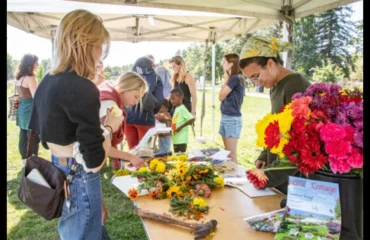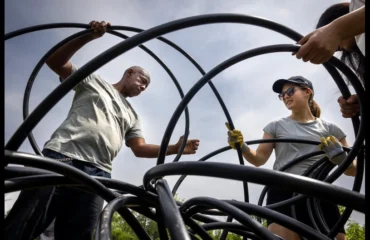Ann Lui Honors Community and Culture through Design
After working at larger corporate practices on tall towers and institutional projects, domestically and overseas, Ann Lui decided to strike out on her own.
In 2015, Lui and her business partner, Craig Reschke, launched Future Firm, a Chicago-based architecture and design research practice that now employs a six-member staff and handles a broad mix of different design projects.
“We started Future Firm in order to be able to have a more immediate impact through design in Chicago and the Midwest, and to be able to work collaboratively with the folks who ultimately live and work in our projects,” Lui says.
“We work for changemakers,” she adds. “These are folks who are trying to do work in their own communities or different industries and have a crazy idea, a dream, or a plan to make changes that architecture can help them achieve. We try to amplify their work through architecture and design research.”
In 2020, Lui extended the reach of her architectural practice to the academic community when she started teaching classes at Taubman College, where she now is an assistant professor of practice.
“I’ve been excited by the support of the college and the students to do work around practice and social equity,” says Lui, who teaches a course on building codes and social equity that examines the historical influence of progressive movements such as disability rights and sustainability initiatives.
“In the studio, we try to think about the bigger-picture questions in architectural practice,” Lui says. “Those questions sometimes get put on the back burner in professional practice when you are focused on completing client projects on time and within budget.”
Lui also enjoys collaborating with students on ideas that work across practice and learning.
“I bring projects to the studio that explore some of the things I’m thinking about,” she says. During the fall 2021 semester, her graduate studio designed a library for Chicago’s Chinatown, “so the students used this project to explore questions about public space and how a library can serve as a community resource,” she adds.
Honoring Community and Culture
For the past two years, Lui has been working pro bono with community members and a coalition of interdisciplinary partners to restore and redevelop the 1917 Central Park Theater in Chicago’s North Lawndale neighborhood. The historic building is owned by the House of Prayer Church of God in Christ.
The project, while still in the very early stages, has a three-pronged focus on community engagement, design and development, and preservation.
“The working vision is a center for community, arts, and culture,” Lui says. “The church would continue to use the building for worship, but it also would house a local theater company, community exhibition space, and performing arts events.”

Central Park Theater. Photo by Nathan Keay.
Future Firm participated in the 2021 Chicago Architecture Biennial by hosting an installation from Swiss architect Manuel Herz that honored the multicultural history of the North Lawndale neighborhood and engaged local residents. Project organizers are now seeking a Landmarks nomination through the City of Chicago to honor and preserve the theater.
“Often architecture is considered something that only very wealthy people can afford because the cost of design services can be prohibitive,” Lui says. “It’s important for us to structure our practice and our values so we can work with folks who are having an impact in their communities in Chicago, particularly on the South Side and West Side, where decades of systemic racism and disinvestment have left some neighborhoods without the amenities, housing, and resources that other parts of the city enjoy.”
Future Firm recently completed the renovation of The Silver Room, a retail store on Chicago’s South Side that has supported local artists and designers for 20 years.
“The space we designed for owner Eric Williams is like an architectural transformer,” Lui says. “By day, it’s a beautiful boutique. By night it becomes a flexible community space that accommodates everything from salsa lessons to community organizing to poetry readings.”
Future Firm is finishing a second project with Williams and his business partner, Cecilia Cuff, that entails construction on the Bronzeville Winery, located in a predominantly African American historic neighborhood on the South Side. The winery, which is owned by and will employ members of the Bronzeville community, will feature one of the neighborhood’s only sit-down restaurants, as well as community space for art, music, and culture. Custom-made and newly commissioned furniture, artwork, and light fixtures designed by South Side artists and designers will provide an upscale look and inviting atmosphere for customers.
Supporting Artists and Night Owls
Future Firm also has used its South Side office to create the Night Gallery, a nocturnal exhibition space run out of the front window from sunset to sunrise during the summer. The project, according to Lui, is intended to feature film and video work by established and emerging artists and architects, to explore new forms of drawing and representation, and to activate public space through curating exhibitions.

The Night Gallery in Chicago
The Night Gallery project has been so successful that Future Firm has partnered with other local organizations in Chicago to start exhibition windows in other businesses that will showcase the work of talented artists and architects.
Future Firm carried the theme to their work as recipients of the 2020–2021 J. Irwin and Xenia Miller Prize, which is the centerpiece of Exhibit Columbus, an annual symposium and exhibition dedicated to architecture, art, design, and community in Columbus, Indiana. The event organizers asked Miller Prize winners to explore the topic “New Middles: From Main Street to Megalopolis, What Is the Future of the Middle City?”
After learning that a significant number of Columbus’s residents work midnight shifts in manufacturing, trucking, and restaurants, Future Firm decided to design a project called “Midnight Palace” for this underserved community of nocturnal denizens. The installation features a “wall of light” inspired by the city’s streetscape and pays homage to the now-shuttered Columbus Drive-In. Video screens feature community partner programming that ranges from cricket matches to short films.
“Midnight Palace is dedicated to the city’s night owls,” Lui says. “For the installation, we curated and showed a series of films on the topic of night workers, including research from Taubman faculty member Cyrus Peñarroyo on Filipinx healthcare workers on the front line. We hope to amplify how the efforts of nighttime workers allow the daylight city to function. These workers are changemakers in that sense.”


